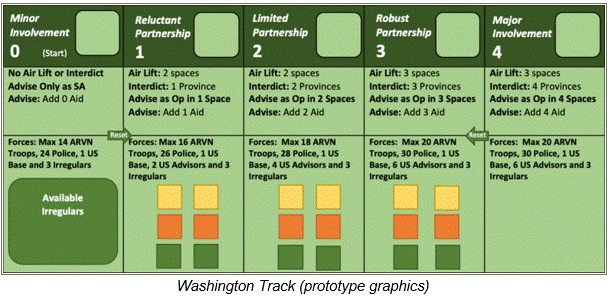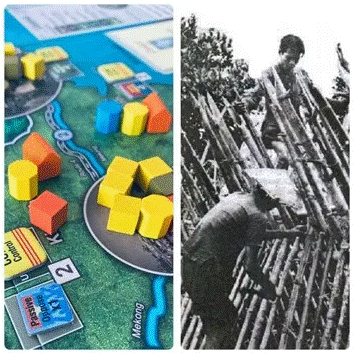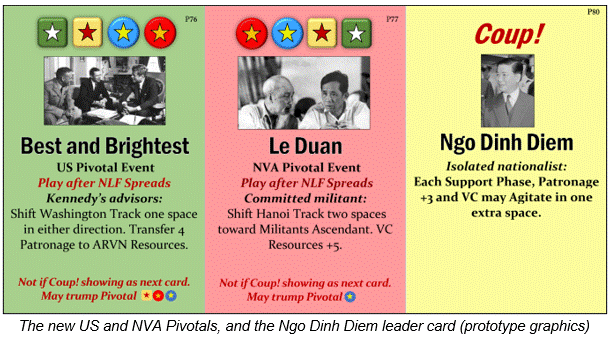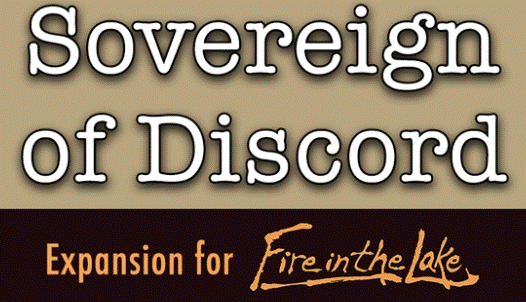Fire in the Lake is my favorite COIN Series game! It is always a great experience sitting at that table for 4-5 hours and playing through the whole of the Vietnam War. To me, the inter-factional dynamics and loose alliances really makes for a tense and interesting experience as you see people work together for a few turns and then turn on each other near the end when victory is in sight. I also have enjoyed the expansion to Fire in the Lake called Fall of Saigon that just came out this past year. With that being said, Stephen Rangazas, who had helped with the research on Fall of Saigon and is now finalizing the design for The British Way, the first COIN Series Multi-Pack, is now designing a prequel of sorts for Fire in the Lake called Sovereign of Discord which was added to the P500 last year. I reached out to Stephen to see if we could get some information on the expansion and he was more than willing to chat.
*Note: The pictures and game art used in this interview, and pictures showing any of the various components and cards, are still in design and are intended to be illustrative only at this point. Also remember that rules might still change prior to final development and publication.
Grant: What drove you to want to design a prequel to Fire in the Lake?
Stephen: While researching the Diem period for a paper that involved the Strategic Hamlet Program, I realized no wargame existed that covered the Diem period at the strategic level. I thought with Fire in the Lake’s focus on faction interactions it perfectly fit the period where the VC and ARVN factions were being backed by external powers providing advisors and assistance. Besides having two advisory factions, Diem’s rule and policies offered a number of ways to make mechanical changes to the base game.

Grant: How does Sovereign of Discord fit into the narrative of Fire in the Lake?
Stephen: The campaign scenario of Fire in the Lake begins in 1964 shortly after the overthrow of Diem and just as the US and NVA are about to intervene with their conventional forces into South Vietnam. Sovereign of Discord pushes back the start date to 1961, right after the NLF insurgency officially formed (more commonly known in the US as Viet Cong) and President Kennedy assumed office. Players will get to see how the United States and North Vietnam gradually escalated toward their positions in 1964, and also why the ARVN failed to stop the growth of the VC insurgency up to the point of triggering American intervention to stop a South Vietnamese collapse. The expansion also includes a Fall of Diem sequence that allows players to continue into the base game allowing them to go all the way to 1972 – or even 1975 with Fall of Saigon!
Grant: What was the reason behind the name “Sovereign of Discord”?
Stephen: Fire in the Lake is named after the famous book by Frances Fitzgerald and her chapter on the Diem period is entitled Sovereign of Discord. Since the expansion is the “chapter” of the game on Diem, I thought that it fit nicely.
Grant: How does Sovereign of Discord attempt to demonstrate how the war escalated from an insurgency between ARVN and Viet Cong and grew into the major Vietnam War after 1965?
Stephen: As alluded to above, US and NVA players in Sovereign of Discord will gradually allow the ARVN and Viet Cong to escalate the size of their available piece pools in the game (up to the amount they would normally have at the start of Fire in the Lake). Likewise, as the advisory presence of each external power grows so does their presence on the map. However, there are no US and NVA troops in the expansion meaning that the semi-conventional feel of the base game is absent. Instead, both US and NVA have the limited ability to use ARVN and VC pieces and the new Strategic Hamlet pieces adds an additional wrinkle to the insurgency and counter-insurgency aspects of the game.
Grant: How does the lower intensity insurgency of the Diem period provide opportunities to use the COIN System?
Stephen: The lower intensity insurgency allows the expansion to focus more on the fight to contain (or spread) the Viet Cong insurgency. US and ARVN players don’t have to worry about large formations of NVA troops crossing over from Laos and Cambodia (or Armor if playing Fall of Saigon) but also lack the hard hitting nature of US troops and Air Strikes for clearing out VC pieces. Therefore, the ARVN must take a more aggressive stance in combating the Viet Cong and also utilize the Strategic Hamlet pieces to lock the Viet Cong out of Province spaces.

Grant: What new mechanics are introduced to reflect the war prior to escalation and the entry of North Vietnam and the United States?
Stephen: The US and NVA players use the Washington and Hanoi Tracks respectively (the Trail track from the base game is not used). Each track represents debates among decision-makers about the level of aid to supply their client in South Vietnam. Additionally, there are new mechanics for the two main differences between the Diem regime from the later ARVN-led revolving door of South Vietnamese governments that characterized the period after American intervention in the base game.
Grant: How do these new mechanics work with the existing framework of COIN?
Stephen: The mechanics integrated into COIN nicely since the series often relies on a track (or tracks) to model politics or external influence in each struggle (US Aid in Cuba Libre, Pakistan in A Distant Plain, Trail in Fire in the Lake). To capture the differences of this earlier period, the expansion introduces three tracks: Washington, Hanoi, and Regime Stability (and removes the Trail from the base game). Although that may sound like a lot of tracks to manage, the Washington and Hanoi Tracks are used to fill out the US and NVA’s more limited action menus given their advisory role, and in the 2-player scenario mainly serve as reinforcement tracks for the ARVN and VC. Regime Stability is also a fairly simple track that fans of the COIN Series may recognize as being inspired by a track in an earlier volume.
Grant: How have the Operations and Special Activities been modified?
Stephen: The VC and ARVN Operations and Special Activities were intentionally kept similar to their base game ones (in part to allow Sovereign of Discord to help ease new players into Fire in the Lake) but do have changes to incorporate the struggle over the Strategic Hamlets (see below). The major changes to OP’s and SA’s come for the US and NVA factions. The US carry overs from the base game are Train, Advise, and Air Lift with small changes to reflect other mechanics in the expansion such as Advisor pieces. In addition, the US has a new Operation, Interdict, that helps them target VC resources directly and also possibly remove NVA cadres. The NVA has essentially an entirely new OP’s and SA’s menu. The NVA may use Infiltrate (different from the base game SA), Direct, and Propagandize as Operations, and Direct and Bombard (different mechanically from base game SA) as Special Activities. Players will need to entirely change their play style for both factions to adjust to their new advisory roles.
Grant: What are the role of ARVN Strategic Hamlet pieces? What do these pieces look like?
Stephen: The Strategic Hamlet pieces model Diem’s major counterinsurgency strategy of fortifying hamlets to deny the Viet Cong access to the population, often requiring the forcible relocation of the civilian population. Strategic Hamlets prevent Rally, Tax, and deny any Opposition in a space from counting towards the Viet Cong’s victory condition. However, Strategic Hamlets require a shift toward Active Opposition when placed with Govern and may be removed with VC Subvert and Attack. The Strategic Hamlet pieces are represented by wooden houses and help count towards the ARVN Control Victory condition. TPA readers who have been following The British Way might note the mechanical similarities with the New Villages used in Malaya, a similar counterinsurgency strategy of relocating civilians into controlled sites.
Grant: What are the Hanoi and Washington Tracks? How do they affect the game?
Stephen: The Washington and Hanoi Tracks release more pieces to Available for each South Vietnamese faction, enhance the type and amount of actions that the US and NVA players can carry out, expand each faction’s board presence through ‘advisor’ pieces (Advisors for US, Cadres for NVA), and finally impact victory (the Washington Track value is subtracted from Support, and NVA Cadres in South Vietnam are added to their Victory Condition). The tracks are impacted by Events, the Coup Round, and the NVA and US Pivotal Events.


Grant: What are the Advisor pieces? How do they allow the US and NVA to enhance the ARVN and VC? What do these pieces look like?

Stephen: The ‘Advisor’ pieces (Advisors for US, Cadres for NVA) model the presence of military and technical advisors supporting each side’s respective client in the South. US Advisors are shown with wooden cubes (reusing US troops from Fire in the Lake) and allow the US to conduct Advise and Interdict while also augmenting ARVN Sweep and Assault. They are modelled with cubes because, by the end of the period covered by the expansion, the US had nearly 16,000 advisors in South Vietnam and many participated in combat roles, such as the secret air campaign Operation Farm Gate.
In contrast, the NVA had a smaller advisory presence in the South, in part to maintain their denial of supporting the insurgency. Their Cadre pieces are cardboard discs (think Tunnels from Fire in the Lake) that must be placed on top of VC Base discs. The NVA Cadres also represent the increasing control that Hanoi has over the southern insurgency, and therefore contribute to their victory condition of Uncontrolled Population + Cadres. NVA Cadres allow the NVA to Propagandize in adjacent Cities, and even allow the NVA to move and attack with VC Guerrillas.
Grant: What is the Regime Stability Track? How does this affect the game?

Stephen: Unlike in the base game where each campaign round represents a successful or failed coup to model the rapidly changing South Vietnamese government, Diem remained in power until the final coup against him in November 1963 (there had been an earlier failed coup in 1960, prior to the start of the expansion). Many scholars also point out that initially the Diem period lacked some of the instability that would characterize later South Vietnamese politics during the period of American escalation. However, in early 1963 with the beginning of the Buddhist Crisis, the stability of the regime began to collapse and widespread coup plotting began (the CIA identified at least three separate plots that summer). Therefore, I needed a way to model this variation. The Regime Stability track was the answer and has two major mechanical features. First, the level of the track alters whether ARVN Operations cost 2, 3, or 4 Resources, meaning that early in the game the ARVN can afford more Operations than in the base game, but usually less in the late game. Second, the track determines how the Event on the final Coup Card, Officer Coup, is resolved. If on Stable or Unstable at the end of the game, the Coup fails and Diem survives, helping the ARVN player win. If on Chaotic, the Coup succeeds and Diem dies, usually helping either US or VC win. When playing an extended campaign game, if Diem survives it alters how the game is transitioned into Fire in the Lake.
Grant: How does the 2-player scenario work? How does Brian Train’s 2-player initiative system from Colonial Twilight match this game?
Stephen: The 2-player scenario is the same length as the 4-player scenario, but VC and ARVN will get more turns since they both act on every card. This means that the 2-player scenario is more focused on the battle around the Strategic Hamlets, while the 4-player scenario involves more negotiation between each patron-client relationship (US-ARVN, VC-NVA). The 2-player initiative system works the same way as Brian’s in Colonial Twilight (like with the Black April scenario in Fall of Saigon), not the new 2-player initiative system used in The British Way and Fred Serval’s A Gest of Robin Hood.
Grant: How many new Events are included for the 1961-1963 scenario?
Stephen: There are 80 new Event Cards: 24 regular Events per year, 3 Coup cards, 1 Diem card, and 4 Pivotal Events.

Grant: How do they differ for the 2-player game?
Stephen: The Events largely don’t change when playing in 2-player, VC and ARVN players simply ignore any reference to NVA/US, and also the 2-player initiative system does not use the eligibility symbols on the top of each card (which can allow players to use Events that they might not usually get an opportunity to act on).
Grant: Can you share a few examples of these Events?
Stephen: Sure, I’ve tried to select three Events around the Buddhist Crisis, a major feature of the Diem period that TPA readers familiar with the Vietnam War will recognize:

Grant: What new Coup! Events are included?
Stephen: Similar to the earlier expansion Fall of Saigon, there are three Coup! Events, one for each year: NLF Spreads for 1961, Buddhist Crisis for 1962, Officer’s Coup for 1963.
Grant: What bonus content is included for the base game? How do these additions change the game?
Stephen: I’ve included bonus content because it has been almost 10 years since Fire in the Lake was first released and the most committed fans (like me) are now pretty familiar with the events and scenarios. Bonus Events also gave me a chance to cover some Events left out of the base game’s deck. There are two new types of bonus content for the base game: Events and Scenarios. The expansion includes 40 new Events for the base game (8 for the 1964 deck, 16 for 1965 decks, 16 for 1968 decks) and also two new short scenarios for the base game: Long 1964 (1964-1965) and Turning Point (1967-1969).

Grant: How does the Sovereign of Discord solitaire system differ from the Tru’ng Bot?
Stephen: The non-player system uses the same Jacquard framework as the Tru’ng bots designed by Bruce Mansfield, but adapted to the particular strategic circumstances of Sovereign of Discord. We’ve called it Minh Mạng, named after a 19th century Vietnamese emperor whose policies and ruling style are somewhat reminiscent of Diem. The non-player Viet Cong and ARVN decks are based fairly directly off their Tru’ng counterparts, as the gameplay for each faction in Sovereign of Discord is not too different, while the non-player NVA and US each just use a single (double-sided) card, as their low board presence makes the behaviour of each faction less variable. Minh Mạng will be very familiar to anyone who has used Tru’ng, Tay Son, or Arjuna, but should also be pretty easy to learn if this is your first experience of the Jacquard card-based non-player system.
Grant: What type of an experience does the game create?
Stephen: I think the expansion creates two major differences in the experience compared to the base game. First, Sovereign of Discord has a bit less going on and therefore is a better game for beginner players interested in the topic (though still plenty hard, maybe in between Cuba Libre and A Distant Plain in complexity). Second, the expansion forces a bit more negotiation between players (when playing the 4-player scenario) than the base game. I’ve found that often in Fire in the Lake games, the VC and NVA can sort of operate independently and you’ll usually see a range of negotiating/cooperating between US and ARVN. In Sovereign of Discord, each South Vietnamese client (ARVN and VC) really must negotiate with their external patron (US and NVA), even if at times they don’t like each other.
Grant: What are you most pleased about with the design?
Stephen: Although I’m quite happy with the patron (US and NVA) and client (ARVN and VC) relations created by the advisory factions in the game, I’m actually most pleased with the comparison between the Strategic Hamlets in Sovereign of Discord and New Villages in The British Way: Malaya. I actually designed Sovereign of Discord first and at the time had no idea I would also do the COIN Series game on Malaya. However, there is a lot of academic literature on why a similar counterinsurgency strategy succeeded in Malaya but failed in South Vietnam. I think the expansion does a nice job of showing how the implementation and structural conditions unique to the conflict in Vietnam (external support, size of South Vietnam, etc…) made the success of the Strategic Hamlet program far less likely than the New Villages.
Grant: What has been the response of playtesters?
Stephen: Many playtesters have appreciated the more negotiation-heavy aspect of Sovereign of Discord and find the advisory factions (US and NVA) still interesting to play despite their more limited presence. One major challenge Joe and I have struggled with from nearly the start of the design is making sure the US and NVA have plenty of interesting choices despite the history mandating their more limited board presence. With the help of feedback from playtesters, I think we’ve managed to accomplish making them engaging factions and their role greatly grows if players continue into Fire in the Lake.
Grant: What other designs are you working on?
Stephen: My main focus now is to finish getting the second COIN Series Multipack polished enough so we can smoothly transition into general testing when GMT is ready for it. Since I’ve basically given away the topic elsewhere, the second multipack will be set in Cold War Latin America. I’ll let your readers try to guess from the many insurgencies in the region which will make the final four.
I’ve also continued working on new insurgency/counterinsurgency game systems to cover what I believe are the gaps left by the COIN Series. COIN does a great job of giving a general overview of a specific topic (and interesting faction dynamics in the multiplayer volumes or a nice range of topics in multipacks) but struggles to cover a few aspects of these types of conflicts. This is not to suggest there is anything wrong with COIN, but abstraction comes at a price and one game system can’t cover everything! One new system I’m working on is to go down to the regional level within conflicts to focus on more operational and organizational issues such as unity of command, rival state-building, and the logistics/economics of mobilizing for each side. Think of games at the Corps level during the Vietnam War or Regional Commands in Afghanistan. The other system focuses less on how these conflicts are conducted and more on how insurgencies begin. COIN games often begin well after the insurgency has formed and consolidated; however, many insurgencies begin quite small (a handful of recruits with even less guns). I think it would be informative for players to see how one gets to the “start” of COIN volumes. In addition, there is an extensive academic literature on the subject of armed group formation and civil war onset that I’d like to make accessible for the wargaming hobby.

Thank you so much for your time in answering our questions so thoroughly and with such context to help us all better understand the intricacies in this entry into the COIN Series. I must say that I have not anticipated a COIN Series game as much as I am this one right now after reading this. I will also be offering Stephen for TPA to host a series of Event Card Spoiler posts for the game and I hope that he will accept.
If you are interested in Sovereign of Discord: A Fire in the Lake Expansion, you can pre-order a copy for $35.00 from the GMT Games website at the following link: https://www.gmtgames.com/p-966-sovereign-of-discord-a-fire-in-the-lake-expansion.aspx
Sovereign of Discord is compatible with the First and Second Editions of Fire in the Lake, as well as the Second Edition Upgrade Kit. The Solitaire System included in Sovereign of Discord is for the Sovereign of Discord only, and cannot be used to play the Scenarios included in Fire in the Lake.
A copy of Fire in the Lake will be necessary to play the Sovereign of Discord expansion.
-Grant

Oh wow! All that new content! I can’t wait to see this!
And to make this article even more amazing, a COIN 4-pack in Latin America!!! That is extremely interesting to me, and I can’t wait to see those as well! And all the other stuff mentioned sounds fascinating too. We’re in a golden age of COIN and COIN-like games, with such fascinating historical themes to explore. I only wish I didn’t have to wait so long for these to be released!!
LikeLiked by 1 person
Now P-500 backed.
LikeLiked by 1 person